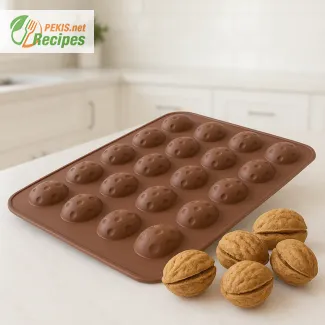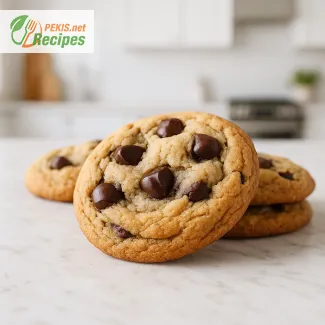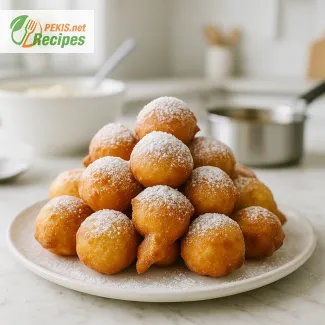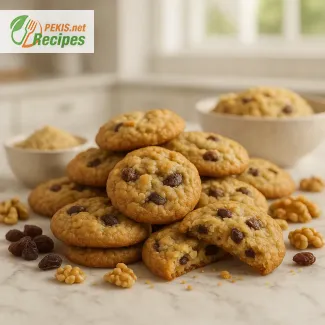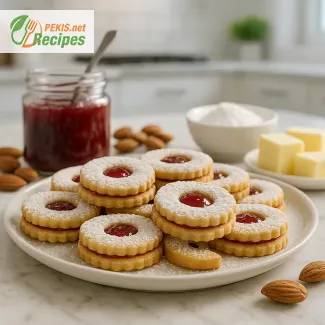Soft and spiced St. Nicholas Devil Cookies make about 20 festive pieces, ready in 40 minutes total (25 min prep, 15 min bake). Made with butter, honey, and warm spices like cinnamon and ginger, they deliver a comforting aroma and perfectly tender texture with crisp golden edges. Their dough can be prepared ahead and chilled, making them ideal for holiday baking. Once baked, store in an airtight tin for up to a week — the flavor deepens over time, making every bite richer and more aromatic.
Years of working with traditional European holiday baking have shown how a simple blend of butter, honey, and warm spices can turn into something truly comforting. The St. Nicholas Devil Cookies recipe carries that balance of flavor and nostalgia — soft inside, lightly crisp outside, and filled with the warmth of cinnamon and ginger. It’s one of those recipes that instantly fills the kitchen with a festive scent and a sense of calm. The key lies in handling the dough gently, giving it time to rest, and baking just until golden for that perfect texture.
PEKIS – professional chef and recipe developer with over 25 years of experience in cooking and baking, specialized in European and international cuisine.

Spiced St. Nicholas Cookies with a Hint of Gingerbread Aroma
A festive European treat inspired by old St. Nicholas traditions
When the scent of cinnamon, honey, and baked dough fills the kitchen, the season of St. Nicholas Day has truly arrived. These traditional St. Nicholas Devil Cookies bring to life the folklore of Central Europe — a tale of kindness and mischief, light and dark, sweetness and spice. Shaped like small mischievous figures or festive motifs, they represent the playful side of the holiday while carrying the warmth of ginger, nutmeg, and cloves. Each cookie has a soft yet slightly crisp texture, with a delicate balance between buttery richness and the aromatic bite of winter spices.
The cookies are especially popular in regions like Slovenia, Austria, and southern Germany, where St. Nicholas (or Miklavž, Nikolaus, Mikuláš) is celebrated on December 6th. In many homes, these cookies are part of a time-honored tradition — baked a few days before, wrapped in paper bags, and handed out to children along with oranges and nuts. Their deep golden color and subtly spiced fragrance capture everything that defines early winter festivities.
The meaning and origin of St. Nicholas Devil Cookies
The “devil” figure, or parkelj, symbolizes the companion of St. Nicholas — a folklore guardian who reminds children to be good. Baking these cookies reflects the spirit of balance between sweetness and mischief, a blend of reward and playful warning. Over time, the recipe evolved from simple honey cookies into more refined versions using butter, flour, sugar, honey, eggs, and a blend of warm spices. Some families still shape them by hand, while others use molds or cutters resembling small devils, stars, or boots.
Why you’ll love this recipe
- Aromatic and nostalgic – the mix of cinnamon, honey, and butter fills your kitchen with festive warmth.
- Soft inside, slightly crisp edges – ideal for enjoying with hot cocoa or mulled wine.
- Traditional yet customizable – you can adjust the spice level or glaze to your taste.
- Perfect for gifting – store beautifully in small paper bags tied with twine.
- Rich in cultural heritage – each cookie tells the story of St. Nicholas and his playful companion.
The role of ingredients and texture
Every ingredient contributes to the cookie’s unique texture and flavor. Butter provides the delicate, melt-in-your-mouth consistency, while honey gives a subtle caramel tone and natural sweetness. Spices such as cinnamon, ginger, and nutmeg add depth and warmth, and flour brings the structure that allows the cookies to hold their shape. For a slightly rustic edge, some bakers use a touch of dark sugar or molasses to enhance the color and aroma.
A closer look at the festive symbolism
These cookies are not just sweets — they embody an old European story. St. Nicholas symbolizes generosity and kindness, while his mischievous counterpart, the parkelj, embodies discipline and playfulness. Together they represent balance — much like the perfect cookie: sweet but spiced, tender yet strong. The red ribbons, small horns, or decorative details are more than mere design; they carry centuries of cultural storytelling that children and adults alike continue to cherish.
Creative variations for your own twist
- Add a thin layer of dark chocolate glaze for a deeper flavor contrast.
- Incorporate ground almonds or hazelnuts for a nutty richness.
- Replace part of the honey with maple syrup for a softer taste.
- For a festive touch, decorate with red icing, edible gold dust, or small sugar pearls.
- Shape them into mini devils, hearts, or boots for different traditions.
Storing and making ahead
These cookies store beautifully when kept in an airtight tin or glass jar at room temperature. Their flavor actually improves after a day or two as the spices deepen and harmonize. You can also prepare the dough in advance — refrigerate it for up to two days before baking. This makes them ideal for busy festive weeks when every moment counts but the aroma of freshly baked cookies is non-negotiable.
Related St. Nicholas recipes you might enjoy
Discover more festive St. Nicholas creations from across Europe that share the same warmth and tradition:
St. Nicholas Croissants: A Traditional Recipe for the Holidays
How to prepare a perfect St. Nicholas breakfast
The sensory essence of St. Nicholas baking
The baking process is an act of celebration — the way the dough softens under warm hands, the fragrance of cloves rising with the heat, the buttery sheen as cookies emerge golden from the oven. Each batch captures the comfort and nostalgia of winter’s most cherished mornings. This isn’t just a treat; it’s a tradition reborn with every aroma that drifts through the air.
Symbolism and European heritage connections
Across borders, from Slovenian Miklavževi parkeljni to German Nikolausgebäck, these cookies connect families and traditions. They are passed down through generations, slightly adapted but always recognizable by their unmistakable scent and heartwarming symbolism. Whether enjoyed with morning coffee or packed in a festive gift box, their story continues — a symbol of kindness, balance, and the joy of baking during the most magical time of year.
- In a large mixing bowl, cream together softened butter, sugar, and honey until the mixture becomes pale and fluffy.
- Add the egg and vanilla extract, mixing until smooth and well combined.
- In a separate bowl, whisk together flour, baking powder, salt, cinnamon, ginger, nutmeg, and cloves.
- Gradually add the dry mixture to the wet ingredients, stirring until a soft, non-sticky dough forms. If the dough feels too dry, add a small splash of milk.
- Wrap the dough in plastic wrap and refrigerate for 30 minutes to allow the flavors to blend and the dough to firm up.
- Preheat the oven to 180 °C (356 °F) and line two baking trays with parchment paper.
- Roll the dough on a lightly floured surface to about 0.5 cm (0.2 inch) thickness. Cut into small devil or festive shapes using cookie cutters.
- Arrange cookies on the trays, leaving some space between them, and bake for 12–15 minutes, or until the edges are lightly golden.
- Let the cookies cool on the tray for 5 minutes before transferring to a wire rack to cool completely.
- Once cooled, drizzle with melted dark chocolate or dust with powdered sugar for a festive finish.
FAQ questionWhat are St. Nicholas Devil Cookies?
St. Nicholas Devil Cookies are soft, spiced holiday cookies traditionally baked for St. Nicholas Day in Central and Eastern Europe. They’re made with butter, honey, brown sugar, flour, and warm spices like cinnamon, ginger, nutmeg, and cloves, then sometimes shaped into playful “devil” or festive figures to echo the folklore around St. Nicholas and his mischievous helper. The result is a tender cookie with lightly crisp edges and a deep, aromatic winter flavor that pairs perfectly with hot cocoa, tea, or mulled wine.
FAQ questionCan I make the dough ahead of time?
Yes. This dough actually benefits from resting in the fridge because the spices have more time to develop and the flour hydrates. After mixing, wrap the dough well and refrigerate for up to 48 hours. Before rolling, let it sit at room temperature for a few minutes so it’s easier to handle. Chilled dough also helps the cookies keep their shape during baking, which is useful if you are cutting them into small devil, star, or boot shapes.
FAQ questionHow do I keep the cookies soft after baking?
To keep them soft, do not overbake — pull them from the oven as soon as the edges turn light golden. Let them cool completely, then store them in an airtight tin or glass jar at room temperature. Adding a small piece of baking parchment with a slice of apple or orange peel (changed daily) can help maintain slight moisture. Because of the honey, these cookies often taste even better the next day as the spices mellow and deepen.
FAQ questionCan I decorate them for kids?
Absolutely. Once cooled, the cookies can be decorated with melted dark or white chocolate, simple sugar glaze, or colored icing. For a more “devil-like” look, you can pipe small horns, eyes, or patterns using red or chocolate icing. If the cookies are for children with sensitivities, skip artificial colors and use natural decorations like chopped nuts, dried cranberries, or sugar pearls. Just make sure decorations are added only after the cookies have fully cooled so the topping sets nicely.
FAQ questionWhat can I substitute if I don’t use honey?
Honey gives these cookies their characteristic aroma and tenderness, but it can be replaced. Use maple syrup for a milder, caramel-like sweetness, or golden syrup for a more neutral taste. Avoid using only granulated sugar, because the texture will be drier and the flavor less rounded. If replacing honey, keep the total liquid-sweetener amount about the same so the dough stays soft but workable.
FAQ questionWhy are these cookies linked to St. Nicholas traditions?
In many European regions, St. Nicholas is accompanied by a playful or slightly scary helper (parkelj, Krampus, or similar figures) who symbolizes discipline and reminds children to behave. Baking “devil” cookies around December 6th is a culinary echo of that tradition — sweet cookies with a mischievous theme. They are often packed with nuts, citrus, or spices because winter feasts used preserved ingredients and warm flavors that made long evenings more pleasant.
FAQ questionCan I freeze them?
Yes, both the unbaked dough and the baked cookies can be frozen. For dough: shape it into a flat disc, wrap tightly, and freeze for up to 2 months. Thaw overnight in the fridge, then roll and bake. For baked cookies: let them cool completely, place in a freezer-safe container with baking paper between layers, and freeze for up to 6 weeks. To serve, bring them back to room temperature; if you want them slightly fresher, warm briefly in a low oven so the spices bloom again.
Baking St. Nicholas Devil Cookies captures the essence of early winter — warmth, nostalgia, and the joy of giving. Their balance of sweetness and spice reflects centuries of tradition that bring families together around the kitchen table. Every golden cookie tells a story of festive aromas, laughter, and moments shared over a simple, homemade treat.
The combination of butter, honey, and seasonal spices turns ordinary ingredients into something memorable. As the cookies bake, the scent of cinnamon and ginger fills the air, creating an unmistakable sense of comfort. Their soft interior and lightly crisp edges make them ideal for cozy evenings, paired with hot drinks or enjoyed straight from the tin.
Beyond their taste, these cookies hold meaning — a reminder of heritage, kindness, and celebration. Each bite carries a touch of tradition that connects generations, blending the playful symbolism of the “devil” with the generosity of St. Nicholas. It’s the kind of recipe that makes the season feel truly alive.
Sharing them is more than offering a dessert; it’s sharing a moment of warmth. Whether baked for family gatherings, school festivities, or quiet evenings at home, St. Nicholas Devil Cookies bring light into the darker days of December, proving that the simplest recipes often create the most lasting memories.
Allergens present in the recipe
- Gluten – present in all-purpose flour.
- Milk – contained in butter and milk.
- Eggs – used in the dough.
Substitution tips for allergens and gluten
- Replace all-purpose flour with a gluten-free baking mix for celiac-friendly cookies.
- Use plant-based butter and non-dairy milk (such as almond or oat milk) to eliminate milk allergens.
- Substitute the egg with a flaxseed mixture (1 tbsp flaxseed meal + 3 tbsp water) for an egg-free version.
- Vitamin B2 – 0.04 mg – supports energy metabolism.
- Calcium – 12 mg – helps maintain healthy bones and teeth.
- Iron – 0.5 mg – contributes to normal oxygen transport in the blood.
- Magnesium – 8 mg – supports muscle and nerve function.
- Potassium – 45 mg – helps regulate fluid balance
- Polyphenols – 25 mg – support cardiovascular health and reduce oxidative stress.
- Flavonoids – 18 mg – promote healthy blood circulation and reduce inflammation.
- Beta-carotene – 0.2 mg – supports skin health and immune function.
